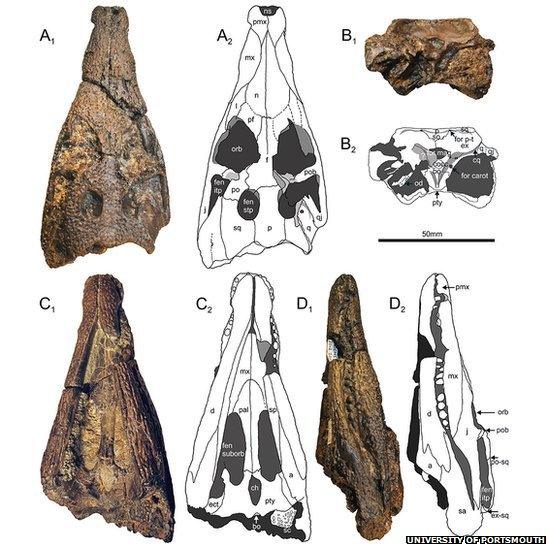Skull fragments reveal new ancient crocodile species
- Published
The species has been named Koumpiodontosuchus aprosdokiti
Two fossilised skull fragments from a 2ft (60cm) crocodile found on the Isle of Wight point to the discovery of a new ancient species, a study has found.
The pieces - a snout and back part of the skull - were found by different private collectors three months apart.
Experts at the Dinosaur Isle museum near Sandown found the 126 million-year-old fragments "fitted together perfectly to make a complete skull".
The species has been named Koumpiodontosuchus aprosdokiti.
The name - meaning "unexpected button-toothed crocodile" - was given by University of Portsmouth palaeontologist Dr Steve Sweetman, who has published a paper on the discovery in the journal Acta Palaeontologica Polonica, external.
The first piece, the skull, was found on a beach near Sandown in March 2011 by Diane Trevarthen who was on a fossil-hunting holiday with her family.
She took it to the museum where staff thought it might belong to a large Cretaceous crocodile baby.
Three months later, Austin and Finley Nathan found the snout while fossil-hunting on their holiday.
When museum staff saw their find, they recalled seeing the other piece and asked Ms Trevarthen to bring it back.
Both collectors donated their specimens to the museum.

The bone structure at the back of the palate of the skull is different to other ancient species
Dr Sweetman said: "Both parts of this wonderful little skull are in good condition, which is most unusual when you consider that crashing waves usually batter and blunt the edges of fossils like this within days or even hours of them being washed onto the beach.
"Both parts must therefore have been found very soon after they were released from the mud and debris originally laid down on a dinosaur-trampled river floodplain around 126 million years ago.
"The sheer serendipity of this discovery is quite bizarre.
"Finding the two parts is in itself remarkable. That they should be found three months apart by different collectors and taken to the museum where the same members of staff were on duty and therefore able to recall the first specimen defies belief."

Dr Steve Sweetman examined the fragments found on the beach near Sandown in 2011
When he first saw it Dr Sweetman thought the skull belonged to a Bernissartia fagesii crocodile, known from skeletons of a similar age discovered in Belgium and Spain.
"I was convinced it was a Bernissartia skull because of its small size - the fully grown animal was only a little over two feet long from nose to tail - but particularly because of its button-shaped teeth, which are unique among crocodyliforms.
"They were used to crush mollusc shells and other invertebrates with tough outer coatings."
But after the skull had been cleaned, Dr Sweetman could see it had significant differences in the arrangement of bones.
"The location of the hole in the mouth, where the airway from the nose opens, was surrounded by bones at the very back of the palate.
"This tells us that the discovery is not only a new species but also a new genus of ancient croc closely related to, but subtly different to, those alive today."

The species has been named Koumpiodontosuchus aprosdokiti
- Published11 March 2014
- Published4 August 2010
- Published4 August 2010